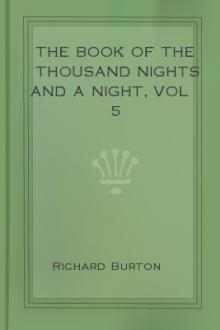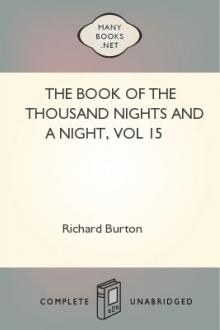The Book of the Thousand Nights and a Night, vol 5 by Sir Richard Francis Burton (red novels txt) 📖

- Author: Sir Richard Francis Burton
- Performer: -
Book online «The Book of the Thousand Nights and a Night, vol 5 by Sir Richard Francis Burton (red novels txt) 📖». Author Sir Richard Francis Burton
[FN#503] A mountain pass near Meccah famous for the “First Fealty of the Steep” (Pilgrimage ii. 126). The mosque was built to commemorate the event.
[FN#504] To my surprise I read in Mr. Redhouse’s “Mesnevi”
(Trubner, 1881), “Arafat, the mount where the victims are slaughtered by the pilgrims.” (p.60). This ignorance is phenomenal. Did Mr. Redhouse never read Burckhardt or Burton?
[FN#505] i.e. listening to the sermon.
[FN#506] It is sad doggrel.
[FN#507] This long story, containing sundry episodes and occupying fifty-three Nights, is wholly omitted by Lane (ii. 643) because “it is a compound of the most extravagant absurdities.”
He should have enabled his readers to form their own judgment.
[FN#508] Called Jamasp (brother and minister of the ancient Persian King Gushtasp) in the translations of Trebutien and others from Von Hammer.
[FN#509] The usual term of lactation in the East, prolonged to two years and a-half, which is considered the rule laid down by the Shara’ or precepts of the Prophet. But it is not unusual to see children of three and even four years hanging to their mothers’ breasts. During this period the mother does not cohabit with her husband; the separation beginning with her pregnancy.
Such is the habit, not only of the “lower animals,” but of all ancient peoples, the Egyptians (from whom the Hebrews borrowed it), the Assyrians and the Chinese. I have discussed its bearing upon pregnancy in my “City of the Saints”: the Mormons insist upon this law of purity being observed; and the beauty, strength and good health of the younger generation are proofs of their wisdom.
[FN#510] Thus distinguishing it from “Asal-kasab,” cane honey or sugar. See vol. i., 271.
[FN#511] The student of Hinduism will remember the N�ga-Kings and Queens (Melusines and Echidn�) who guard the earth-treasures in Naga-land. The first appearance of the snake in literature is in Egyptian hieroglyphs, where he forms the letters f and t, and acts as a determinative in the shape of a Cobra di Capello (Coluber Naja) with expanded hood.
[FN#512] In token that he was safe.
[FN#513] “Akhir al-Zam�n.” As old men praise past times, so prophets prefer to represent themselves as the last. The early Christians caused much scandal amongst the orderly law-loving Romans by their wild and mistaken predictions of the end of the world being at hand. The catastrophe is a fact for each man under the form of death; but the world has endured for untold ages and there is no apparent cause why it should not endure as many more.
The “latter days,” as the religious dicta of most “revelations”
assure us, will be richer in sinners than in sanctity: hence “End of Time” is a facetious Arab title for a villain of superior quality. My Somali escort applied it to one thus distinguished: in 1875, I heard at Aden that he ended life by the spear as we had all predicted.
[FN#514] Jahannam and the other six Hells are personified as feminine; and (woman-like) they are somewhat addicted to prolix speechification.
[FN#515] These puerile exaggerations are fondly intended to act as nurses frighten naughty children.
[FN#516] Alluding to an oft-quoted saying “Lau l�-ka, etc.
Without thee (O Mohammed) We (Allah) had not created the spheres,” which may have been suggested by “Before Abraham was, I am” (John viii. 58); and by Gate xci. of Zoroastrianism “O
Zardusht for thy sake I have created the world” (Dabistan i.
344). The sentiment is by no means “Shi’ah,” as my learned friend Prof. Aloys Springer supposes. In his Mohammed (p. 220) we find an extract from a sectarian poet, “For thee we dispread the earth; for thee we caused the waters to flow; for thee we vaulted the heavens.” As Baron Alfred von Kremer, another learned and experienced Orientalist, reminds me, the “Shi’ahs” have always shown a decided tendency to this kind of apotheosis and have deified or quasi-deified Ali and the Imams. But the formula is first found in the highly orthodox Burdah poem of Al-Busiri:—
“But for him (Lau l�-hu) the world had never come out of nothingness.”
Hence it has been widely diffused. See Les Aventures de Kamrup (pp. 146-7) and Les �uvres de Wali (pp. 51-52), by M. Garcin de Tassy and the Dabistan (vol. i. pp. 2-3).
[FN#517] Arab. “S�miy�” from the Pers., a word apparently built on the model of “K�miy�” = alchemy, and applied, I have said, to fascination, minor miracles and white magic generally like the Hindu “Indrajal.” The common term for Alchemy is Ilm al-K�f (the K-science) because it is not safe to speak of it openly as Alchemy.
[FN#518] Mare Tenebrarum = Sea of Darknesses; usually applied to the “mournful and misty Atlantic.”
[FN#519] Some Moslems hold that Solomon and David were buried in Jerusalem, others on the shore of Lake Tiberias. Mohammed, according to the history of Al-Tabari (p. 56 vol. i. Duleux’s “Chronique de Tabari”) declares that the Jinni bore Solomon’s corpse to a palace hewn in the rock upon an island surrounded by a branch of the “Great Sea” and set him on a throne, with his ring still on his finger, under a guard of twelve Jinns. “None hath looked upon the tomb save only two, Affan who took Bulukiya as his companion: with extreme pains they arrived at the spot, and Affan was about to carry off the ring when a thunderbolt consumed him. So Bulukiya returned.”
[FN#520] Koran xxxviii. 34, or, “art the liberal giver.”
[FN#521] i.e. of the last trumpet blown by the Archangel Israfil: an idea borrowed from the Christians. Hence the title of certain churches—ad Tubam.
[FN#522] This may mean that the fruits were fresh and dried like dates or tamarinds (a notable wonder), or soft and hard of skin like grapes and pomegranates.
[FN#523] Arab. “Ai-lks�r” meaning lit. an essence; also the philosopher’s stone.
[FN#524] Name of the Jinni whom Solomon imprisoned in Lake Tiberias (See vol. i., 41).
[FN#525] Vulgarly pronounced “Jahannum.” The second hell is usually assigned to Christians. As there are seven Heavens (the planetary orbits) so, to satisfy Moslem love of symmetry, there must be as many earths and hells under the earth. The Egyptians invented these grim abodes, and the marvellous Persian fancy worked them into poem.
[FN#526] Arab. “Y�j�j and Majuj,” first named in Gen. x. 2, which gives the ethnology of Asia Minor, circ. B.C. 800. “Gomer” is the Gimri or Cymmerians; “Magog” the original Magi, a division of the Medes, “Javan” the Ionian Greeks, “Meshesh” the Moschi; and “Tires” the Turusha, or primitive Cymmerians. In subsequent times, “Magog” was applied to the Scythians, and modern Moslems determine from the Koran (chaps. xviii. and xxi.) that Yajuj and Majuj are the Russians, whom they call Moska or Moskoff from the Moskwa River,
[FN#527] I attempt to preserve the original pun; “Mukarrabin”
(those near Allah) being the Cherubim, and the Creator causing Iblis to draw near Him (karraba).
[FN#528] A vulgar version of the Koran (chaps. vii.), which seems to have borrowed from the Gospel of Barnabas. Hence Adam becomes a manner of God-man.
[FN#529] These wild fables are caricatures of Rabbinical legends which began with “Lilith,” the Spirit-wife of Adam: Nature and her counterpart, Physis and Antiphysis, supply a solid basis for folk-lore. Amongst the Hindus we have Brahma (the Creator) and Viswakarm�, the anti-Creator: the former makes a horse and a bull and the latter caricatures them with an ass and a buffalo, and so forth.
[FN#530] This is the “Lauh al-Mahf�z,” the Preserved Tablet, upon which are written all Allah’s decrees and the actions of mankind good (white) and evil (black). This is the “perspicuous Book” of the Koran, chaps. vi. 59. The idea again is Guebre.
[FN#531] i.e. the night before Friday which in Moslem parlance would be Friday night.
[FN#532] Again Persian “G�w-i-Zam�n” = the Bull of the Earth.
“The cosmogony of the world,” etc., as we read in the Vicar of Wakefield.
[FN#533] The Calc. Edit. ii. 614. here reads by a clerical error “bull.”
[FN#534] i.e. Lakes and rivers.
[FN#535] Here some abridgement is necessary, for we have another recital of what has been told more than once.
[FN#536] This name, “King of Life,” is Persian: “Tegh” or “Tigh”
means a scimitar and “Bahrw�n,” is, I conceive, a mistake for “Bihr�n,” the Persian name of Alexander the Great.
[FN#537] Arab. “Mul�k�t” or meeting the guest which, I have said, is an essential part of Eastern ceremony, the distance from the divan, room, house or town being proportioned to his rank or consideration.
[FN#538] Arab. “Sifr”: whistling is held by the Badawi to be the speech of devils; and the excellent explorer Burckhardt got a bad name by the ugly habit.
[FN#539] The Arabs call “Shikk” (split man) and the Persians “N�mchahrah” (half-face) a kind of demon like a man divided longitudinally: this gruesome creature runs with amazing speed and is very cruel and dangerous. For the celebrated soothsayers “Shikk” and “S�tih” see Chenery’s Al-Hariri, p. 371.
[FN#540] Arab. “Takht” (Persian) = a throne or a capital.
[FN#541] Arab. “Wady al-Naml”; a reminiscence of the Koranic Wady (chaps. xxvii.), which some place in Syria and others in T�if.
[FN#542] This is the old, old fable of the River Sabbation which Pliny ((xxx). 18) reports as “drying up every Sabbath-day”
(Saturday): and which Josephus reports as breaking the Sabbath by flowing only on the Day of Rest.
[FN#543] They were keeping the Sabbath. When lodging with my Israelite friends at Tiberias and Safet, I made a point of never speaking to them (after the morning salutation) till the Saturday was over.
[FN#544] Arab. “La’al” and “Y�k�t,” the latter also applied to the garnet and to a variety of inferior stones. The ruby is supposed by Moslems to be a common mineral thoroughly “cooked” by the sun, and produced only on the summits of mountains inaccessible even to Alpinists. The idea may have originated from exaggerated legends of the Badakhsh�n country (supposed to be the home of the ruby) and its terrors of break-neck foot-paths, jagged peaks and horrid ravines: hence our “balas-ruby” through the Spanish corruption “Balaxe.” Epiphanius, archbishop of Salamis in Cyprus, who died A.D. 403, gives, m a little treatise (De duodecim gemmis rationalis summi sacerdotis Hebr�orum Liber, opera Fogginii, Romae, 1743, p. 30), a precisely similar description of the mode of finding jacinths in Scythia. “In a wilderness in the interior of Great Scythia,” he writes, “there is a valley begirt with stony mountains as with walls. It is inaccessible to man, and so excessively deep that the bottom of the valley is invisible from the top of the surrounding mountains. So great is the darkness that it has the effect of a kind of chaos. To this place certain criminals are condemned, whose task it is to throw down into the valley slaughtered lambs, from which the skin has been first taken off. The little stones adhere to these pieces of flesh. Thereupon the eagles, which live on the summits of the mountains, fly down following the scent of the flesh, and carry away the lambs with the stones adhering to them. They, then, who are condemned to this place watch until the eagles have finished their meal, and run and take away the stones.” Epiphanius, who wrote this, is spoken of in terms of great respect by many ecclesiastical writers, and St. Jerome styles the treatise here quoted, “Egregium volumen, quod si legere volueris, plenissimam scientiam consequeris ,” and, indeed, it is by no means improbable that it was from the account of





Comments (0)